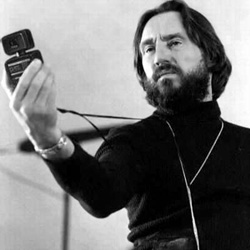 The
The
documentary Visions of Light, about the process of cinematography, was a
revelation for me. It arrived just as I was becoming more deeply interested in
the intricacies of filmmaking, and perfectly articulated core concepts about
how to intertwine visuals and narrative. It’s got brilliant tales like William Fraker’s story
about Roman Polanski telling him where to place the camera when Mia Farrow
dodges into her bedroom to take a phone call in Rosemary’s Baby. She’s
obscured by the doorframe, and Fraker describes watching an entire audience
crane their necks to look around the frame and into the room.
Two of
the most notable directors of photography in Visions are Vilmos
Zsigmond and Laszlo Kovacs, who escaped the Hungarian revolution together in
the mid-50s, carrying footage of the conflict across the border into
through classic New Hollywood films like The Deer Hunter (Zsigmond) and Easy
Rider (Kovacs). And while the latter doesn’t hold up dramatically
today, it remains a landmark in the liberation of cinematography.
Now the
pair will be the subject of a new documentary, Laszlo & Vilmos: The Story Of
Two Refugees Who Changed The Look Of American Cinema. That’s an unwieldy
title – I would have gone simply with Laszlo & Vilmos, which might pull in
fans of Hardcastle & McCormick, Simon & Simon and Real Genius. Vilmos Zsigmond also shot
Real Genius, by the way – proof of his wide-ranging skills.
No
documentary about filmmaking would be complete without famous talking heads, so
expect Dennis Hopper, Haskell Wexler, Martin Scorsese and Owen Roizman to
appear. (Wexler’s Medium Cool, incidentally, is interesting enough from a photographic
perspective to warrant a new documentary as well.)
Cinematographer
James Chressanthis, who interned with Zsigmond on The Witches of Eastwick,
is directing the doc. Based on anecdotes I’ve heard from other crewpeople who’ve
worked with Vilmos, I’m not at all surprised that the experience, even twenty
years ago, was enough to gestate the idea for this film in Chressanthis’s mind.